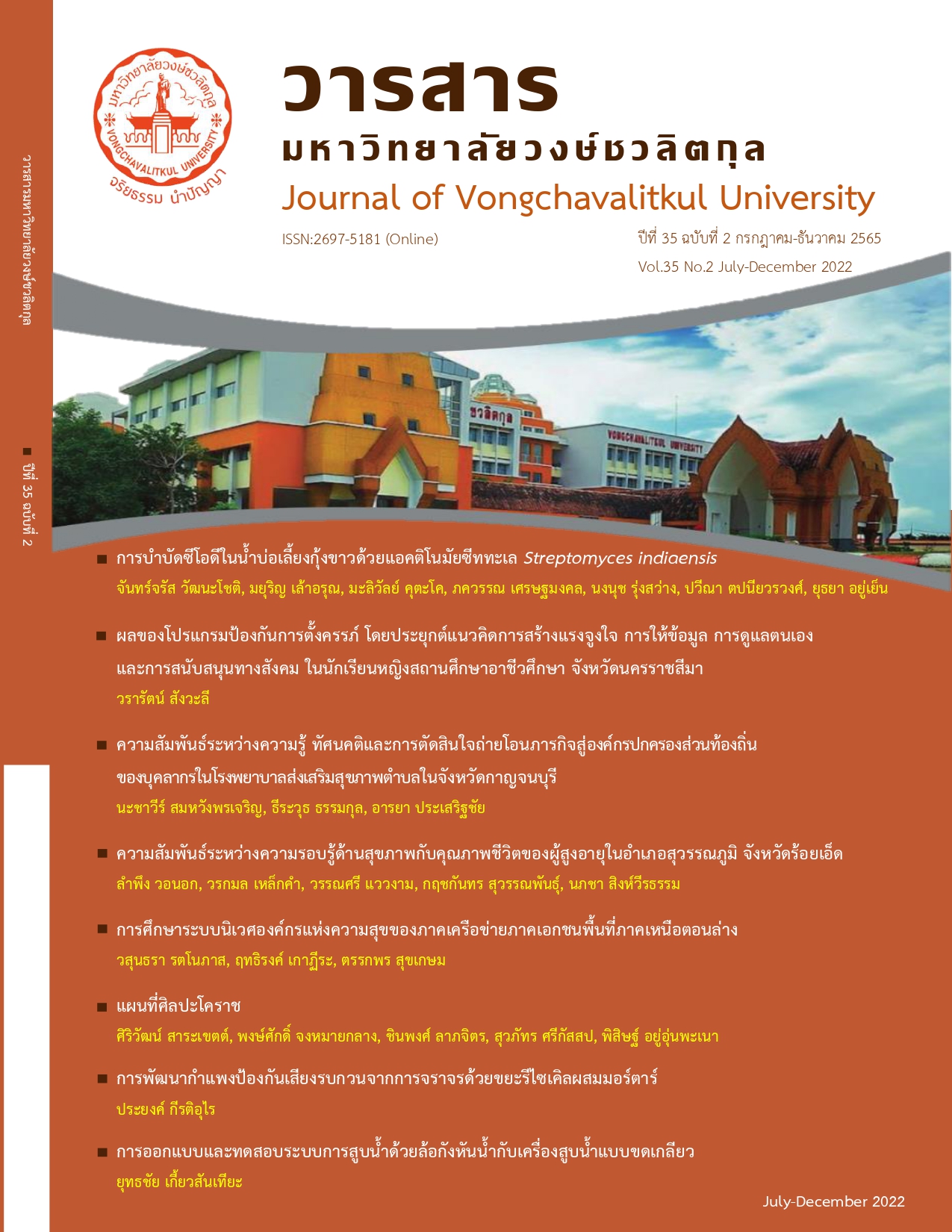The COD Removal in White Shrimp Pond Wastewater with Marine Actinomycetes Streptomyces indiaensis
Main Article Content
Abstract
Objective: The amount of organic substance in Pacific white shrimp pond (Litopenaeus vannamei) will accumulate according to time spent on breeding shrimps. This research studied the morphology and COD (Chemical oxygen demand) reduction efficiency of marine actinomycete Streptomyces indiaensis in order to create a guideline for using Actinomycete in wastewater treatment for coastal aquaculture.
Methods: The morphology of actinomycete S. indiaensis isolated from a mangrove forest was studied using Gram’s staining method and observed under a light microscope. Actinomycete was cultured in standard ISP2 medium and water from a Pacific white shrimp pond. Then, actinomycete S. indiaensis was used to reduce COD in water from the shrimp pond and compared with not using actinomycete S. indiaensis.
Results: Gram’s staining test revealed that marine actinomycete S.indiaensis is filamentous gram-positive bacteria. Marine actinomycete S. indiaensis could grow in a standard ISP2 medium better than in the shrimp pond water. Thereafter, a reduction of the COD in shrimp pond water was performed. The initial COD concentration in shrimp pond water was 662 mg/L. The use of S. indiaensis was able to reduce the amount of COD in the shrimp pond water in a greater manner than without S. indiaensis. The use of actinomycete had complete COD treatment within 21 days, whereas the comparison without the use of actinomycete could be treated at 78%. The results from this experiment showed that a marine actinomycete
S. indiaensis was able to reduce COD faster than the native bacteria in the shrimp pond water.
Article Details

This work is licensed under a Creative Commons Attribution-NonCommercial-NoDerivatives 4.0 International License.
References
ณิษา สิรนนท์ธนา, มะลิวัลย์ คุตะโค, พัฒน ศิลปชัย และ จันทร์จรัส วัฒนะโชติ. (2562). ประสิทธิภาพของแอคติโนมัยซีททะเลในการลดค่าซีโอดีในน้ำเสียสังเคราะห์แป้งมันสำปะหลัง. แก่นเกษตร, 47 (ฉบับพิเศษ 1), 1247-1252.
ประกาศกระทรวงเกษตรและสหกรณ์. (2558). ราชกิจจานุเบกษา เรื่อง กําหนดมาตรฐานสินค้าเกษตร : แนวปฏิบัติในการใช้มาตรฐานสินค้าเกษตร การปฏิบัติทางการเพาะเลี้ยงสัตว์น้ำที่ดีสําหรับฟาร์มเลี้ยงกุ้งทะเล ตามพระราชบัญญัติมาตรฐานสินค้าเกษตร พ.ศ. 2551. เล่มที่ 132 ตอนพิเศษ 179ง.
ประกาศกระทรวงทรัพยากรธรรมชาติและสิ่งแวดล้อม. (2547). ราชกิจจานุเบกษา เรื่องกำหนดมาตรฐานควบคุมการระบายน้ำทิ้งจากบ่อเพาะเลี้ยงสัตว์น้ำชายฝั่ง. เล่มที่ 121 ตอนพิเศษที่ 49.
ประกาศกระทรวงวิทยาศาสตร์ เทคโนโลยีและสิ่งแวดล้อม. (2539). ราชกิจจานุเบกษา เรื่อง กำหนดประเภทของโรงงานอุตสาหกรรมและนิคมอุตสาหกรรม เป็นแหล่งกำเนิดมลพิษที่จะต้องถูกควบคุมการปล่อยน้ำเสียลงสู่แหล่งน้ำสาธารณะหรือออกสู่สิ่งแวดล้อม. เล่มที่ 113 ตอนที่ 13ง.
รัตนาภรณ์ ศรีวิบูรณ์ และ จันทร์จรัส วัฒนะโชติ. (2558). การพัฒนาการผลิตสารออกฤทธิ์ชีวภาพจากแอคติโนมัยซีทและการผลิตเซลล์ปริมาณมาก. รายงานวิจัยฉบับสมบูรณ์. ชลบุรี: มหาวิทยาลัยบูรพา.
Antileo, A., Roeckel, M., & Wiesmann, U. (2003). High nitrite buildup during nitrification in a rotating disk reactor. Water Environment Research, 75(2), 151-162.
APHA. (1992). Standard method for the examination of water and wastewater (18th ed.). Washington, D.C.: America Public Health
Association.
Bezak-Mazur, E., Stoińska, R., Rajca, J., & Latasiewicz, E. (2017). Effect of the presence of Actinomycetes in the activated sludge on the quality of the treated wastewater. E3S Web of Conferences, 17, 00007.
Biao, X., Tingyou, L., Xipei, W., & Yi, Q. (2009). Variation in the water quality of organic and conventional shrimp ponds in a coastal environment from Eastern China. Bulgarian Journal of Agricultural Science, 15(1), 47-59.
Bower, C. E., & Holm-Hansen, T. (1980). A salicylate–hypochlorite method for determining ammonia in seawater. Canadian Journal of
Fisheries and Aquatic Sciences, 37(5), 794-798.
EPA. (1978). Method 410.3: Chemical oxygen demand (titrimetric, high level for saline waters) by titration. United States: United States Environmental Protection Agency.
Grasshoff, K., Kremling, K., & Ehrhardt, M. (1999). Methods of seawater analysis (3nd ed.). Weinheim, New York, Rochester, Brisbane,
Singapore, Toronto: John Wiley & Sons.
Gross, A., Abutbu, S, & Zilberg, D. (2004). Acute and chronic effects of nitrite on white shrimp, Litopenaeus vannamei, cultured in low-salinity brackish water. Journal of The World Aquaculture Society, 35(3), 315-321.
Hozzein, W. N., Ahmed, M. B., & Tawab, M. S. A. (2012). Efficiency of some actinomycete isolates in biological treatment and removal of heavy metals from wastewater. African Journal of Biotechnology, 11(5), 1163-1168.
Kumar, V., Bharti, A., Negi, Y. K., Gusain, O., Pandey, P., & Bisht, G. S. (2012). Screening of actinomycetes from earthworm castings for their antimicrobial activity and industrial enzymes. Brazilian Journal of Microbiology, 43, 205-214.
Kurniawati, N., Meryandini, A., & Sunarti, T. C. (2016). Introduction of actinomycetes starter on coffee fruits fermentation to enhance quality of coffee pulp. Emirates Journal of Food and Agriculture, 28(3), 188-195.
Li, B. & Irvin, S. (2007). The comparison of alkalinity and ORP as indicators for nitrification and denitrification in a sequencing batch reactor (SBR). Biochemical Engineering Journal, 34(3), 248-255.
Madkour, A. G., Hamed, M. M., & Dar, M. A. (2019). Removal of ammonia and orthophosphate from domestic wastewater using marine actinomycetes. Egyptian Journal of Aquatic Biology and Fisheries, 23(3), 455-465.
Malviya, M. K., Pandey, A., Sharma, A., & Tiwari, S. C. (2013). Characterization and identification of actinomycetes isolated from ‘fired plots’ under shifting cultivation in northeast Himalaya, India. Annals of microbiology, 63(2), 561-569.
Rathore, D. S., Sheikh, M., Gohel, S., & Singh, S. P. (2019). Isolation strategies, abundance and characteristics of the marine actinomycetes of Kachhighadi, Gujarat, India. Journal of the Marine Biological Association of India, 61(1), 71-78.
Santamaría, R. I., Martínez-Carrasco, A., Sánchez de la Nieta, R., Torres-Vila, L. M., Bonal, R., Martín, J., ... Díaz, M. (2020). Characterization of actinomycetes strains isolated from the intestinal tract and feces of the larvae of the longhorn beetle Cerambyx welensii. Microorganisms, 8(12), 2013.
Shirling, E.B., & Gottlieb, D. (1966). Methods for characterization of streptomyces species. International Journal of systematic bacteriology, 16(3), 313–340.
Strickland, J. D. H., & Parsons, T. R. (1972). A practical handbook of seawater analysis. Fisheries research board of Canada. Ottawa: The Alger Press.
Team, R. C. (2020). R: A language and environment for statistical computing. R Foundation for Statistical Computing, Vienna, Austria. Copenhagen: European Environment Agency.


